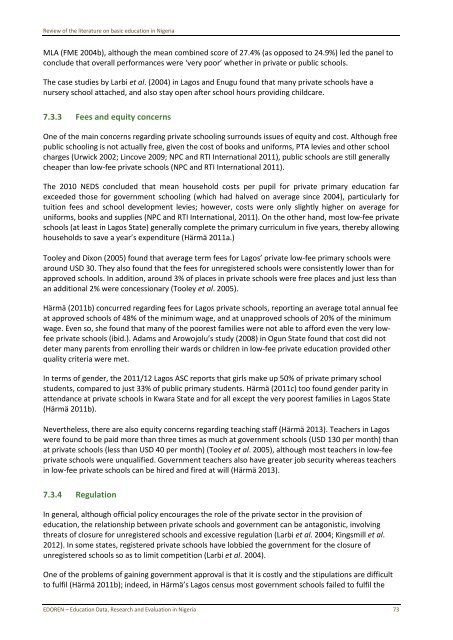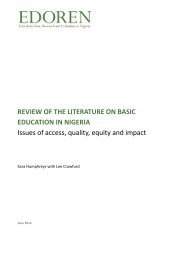Review <str<strong>on</strong>g>of</str<strong>on</strong>g> <str<strong>on</strong>g>the</str<strong>on</strong>g> <str<strong>on</strong>g>literature</str<strong>on</strong>g> <strong>on</strong> <strong>basic</strong> educati<strong>on</strong> <strong>in</strong> NigeriaMLA (FME 2004b), although <str<strong>on</strong>g>the</str<strong>on</strong>g> mean comb<strong>in</strong>ed score <str<strong>on</strong>g>of</str<strong>on</strong>g> 27.4% (as opposed to 24.9%) led <str<strong>on</strong>g>the</str<strong>on</strong>g> panel toc<strong>on</strong>clude that overall performances were ‘very poor’ whe<str<strong>on</strong>g>the</str<strong>on</strong>g>r <strong>in</strong> private or public schools.The case studies by Larbi et al. (2004) <strong>in</strong> Lagos and Enugu found that many private schools have anursery school attached, and also stay open after school hours provid<strong>in</strong>g childcare.7.3.3 Fees and equity c<strong>on</strong>cernsOne <str<strong>on</strong>g>of</str<strong>on</strong>g> <str<strong>on</strong>g>the</str<strong>on</strong>g> ma<strong>in</strong> c<strong>on</strong>cerns regard<strong>in</strong>g private school<strong>in</strong>g surrounds issues <str<strong>on</strong>g>of</str<strong>on</strong>g> equity and cost. Although freepublic school<strong>in</strong>g is not actually free, given <str<strong>on</strong>g>the</str<strong>on</strong>g> cost <str<strong>on</strong>g>of</str<strong>on</strong>g> books and uniforms, PTA levies and o<str<strong>on</strong>g>the</str<strong>on</strong>g>r schoolcharges (Urwick 2002; L<strong>in</strong>cove 2009; NPC and RTI Internati<strong>on</strong>al 2011), public schools are still generallycheaper than low-fee private schools (NPC and RTI Internati<strong>on</strong>al 2011).The 2010 NEDS c<strong>on</strong>cluded that mean household costs per pupil for private primary educati<strong>on</strong> farexceeded those for government school<strong>in</strong>g (which had halved <strong>on</strong> average s<strong>in</strong>ce 2004), particularly fortuiti<strong>on</strong> fees and school development levies; however, costs were <strong>on</strong>ly slightly higher <strong>on</strong> average foruniforms, books and supplies (NPC and RTI Internati<strong>on</strong>al, 2011). On <str<strong>on</strong>g>the</str<strong>on</strong>g> o<str<strong>on</strong>g>the</str<strong>on</strong>g>r hand, most low-fee privateschools (at least <strong>in</strong> Lagos State) generally complete <str<strong>on</strong>g>the</str<strong>on</strong>g> primary curriculum <strong>in</strong> five years, <str<strong>on</strong>g>the</str<strong>on</strong>g>reby allow<strong>in</strong>ghouseholds to save a year’s expenditure (Härmä 2011a.)Tooley and Dix<strong>on</strong> (2005) found that average term fees for Lagos’ private low-fee primary schools werearound USD 30. They also found that <str<strong>on</strong>g>the</str<strong>on</strong>g> fees for unregistered schools were c<strong>on</strong>sistently lower than forapproved schools. In additi<strong>on</strong>, around 3% <str<strong>on</strong>g>of</str<strong>on</strong>g> places <strong>in</strong> private schools were free places and just less thanan additi<strong>on</strong>al 2% were c<strong>on</strong>cessi<strong>on</strong>ary (Tooley et al. 2005).Härmä (2011b) c<strong>on</strong>curred regard<strong>in</strong>g fees for Lagos private schools, report<strong>in</strong>g an average total annual feeat approved schools <str<strong>on</strong>g>of</str<strong>on</strong>g> 48% <str<strong>on</strong>g>of</str<strong>on</strong>g> <str<strong>on</strong>g>the</str<strong>on</strong>g> m<strong>in</strong>imum wage, and at unapproved schools <str<strong>on</strong>g>of</str<strong>on</strong>g> 20% <str<strong>on</strong>g>of</str<strong>on</strong>g> <str<strong>on</strong>g>the</str<strong>on</strong>g> m<strong>in</strong>imumwage. Even so, she found that many <str<strong>on</strong>g>of</str<strong>on</strong>g> <str<strong>on</strong>g>the</str<strong>on</strong>g> poorest families were not able to afford even <str<strong>on</strong>g>the</str<strong>on</strong>g> very lowfeeprivate schools (ibid.). Adams and Arowojolu’s study (2008) <strong>in</strong> Ogun State found that cost did notdeter many parents from enroll<strong>in</strong>g <str<strong>on</strong>g>the</str<strong>on</strong>g>ir wards or children <strong>in</strong> low-fee private educati<strong>on</strong> provided o<str<strong>on</strong>g>the</str<strong>on</strong>g>rquality criteria were met.In terms <str<strong>on</strong>g>of</str<strong>on</strong>g> gender, <str<strong>on</strong>g>the</str<strong>on</strong>g> 2011/12 Lagos ASC reports that girls make up 50% <str<strong>on</strong>g>of</str<strong>on</strong>g> private primary schoolstudents, compared to just 33% <str<strong>on</strong>g>of</str<strong>on</strong>g> public primary students. Härmä (2011c) too found gender parity <strong>in</strong>attendance at private schools <strong>in</strong> Kwara State and for all except <str<strong>on</strong>g>the</str<strong>on</strong>g> very poorest families <strong>in</strong> Lagos State(Härmä 2011b).Never<str<strong>on</strong>g>the</str<strong>on</strong>g>less, <str<strong>on</strong>g>the</str<strong>on</strong>g>re are also equity c<strong>on</strong>cerns regard<strong>in</strong>g teach<strong>in</strong>g staff (Härmä 2013). Teachers <strong>in</strong> Lagoswere found to be paid more than three times as much at government schools (USD 130 per m<strong>on</strong>th) thanat private schools (less than USD 40 per m<strong>on</strong>th) (Tooley et al. 2005), although most teachers <strong>in</strong> low-feeprivate schools were unqualified. Government teachers also have greater job security whereas teachers<strong>in</strong> low-fee private schools can be hired and fired at will (Härmä 2013).7.3.4 Regulati<strong>on</strong>In general, although <str<strong>on</strong>g>of</str<strong>on</strong>g>ficial policy encourages <str<strong>on</strong>g>the</str<strong>on</strong>g> role <str<strong>on</strong>g>of</str<strong>on</strong>g> <str<strong>on</strong>g>the</str<strong>on</strong>g> private sector <strong>in</strong> <str<strong>on</strong>g>the</str<strong>on</strong>g> provisi<strong>on</strong> <str<strong>on</strong>g>of</str<strong>on</strong>g>educati<strong>on</strong>, <str<strong>on</strong>g>the</str<strong>on</strong>g> relati<strong>on</strong>ship between private schools and government can be antag<strong>on</strong>istic, <strong>in</strong>volv<strong>in</strong>gthreats <str<strong>on</strong>g>of</str<strong>on</strong>g> closure for unregistered schools and excessive regulati<strong>on</strong> (Larbi et al. 2004; K<strong>in</strong>gsmill et al.2012). In some states, registered private schools have lobbied <str<strong>on</strong>g>the</str<strong>on</strong>g> government for <str<strong>on</strong>g>the</str<strong>on</strong>g> closure <str<strong>on</strong>g>of</str<strong>on</strong>g>unregistered schools so as to limit competiti<strong>on</strong> (Larbi et al. 2004).One <str<strong>on</strong>g>of</str<strong>on</strong>g> <str<strong>on</strong>g>the</str<strong>on</strong>g> problems <str<strong>on</strong>g>of</str<strong>on</strong>g> ga<strong>in</strong><strong>in</strong>g government approval is that it is costly and <str<strong>on</strong>g>the</str<strong>on</strong>g> stipulati<strong>on</strong>s are difficultto fulfil (Härmä 2011b); <strong>in</strong>deed, <strong>in</strong> Härmä’s Lagos census most government schools failed to fulfil <str<strong>on</strong>g>the</str<strong>on</strong>g>EDOREN – Educati<strong>on</strong> Data, Research and Evaluati<strong>on</strong> <strong>in</strong> Nigeria 73
Review <str<strong>on</strong>g>of</str<strong>on</strong>g> <str<strong>on</strong>g>the</str<strong>on</strong>g> <str<strong>on</strong>g>literature</str<strong>on</strong>g> <strong>on</strong> <strong>basic</strong> educati<strong>on</strong> <strong>in</strong> Nigeriarequirements demanded <str<strong>on</strong>g>of</str<strong>on</strong>g> private schools (ibid.). Moreover, government frequently does not havecapacity for effective supervisi<strong>on</strong> <str<strong>on</strong>g>of</str<strong>on</strong>g> ei<str<strong>on</strong>g>the</str<strong>on</strong>g>r public or private schools (Larbi et al. 2004).7.4 Christian school<strong>in</strong>gMissi<strong>on</strong> schools provided much <str<strong>on</strong>g>of</str<strong>on</strong>g> <str<strong>on</strong>g>the</str<strong>on</strong>g> first educati<strong>on</strong> available <strong>in</strong> Nigeria, but many <str<strong>on</strong>g>of</str<strong>on</strong>g> <str<strong>on</strong>g>the</str<strong>on</strong>g>se schoolswere nati<strong>on</strong>alised <strong>in</strong> <str<strong>on</strong>g>the</str<strong>on</strong>g> 1970s (Larbi et al. 2004). There has more recently been a trend <strong>in</strong> many statestoward re-privatis<strong>in</strong>g many <str<strong>on</strong>g>of</str<strong>on</strong>g> <str<strong>on</strong>g>the</str<strong>on</strong>g>se schools, <strong>in</strong> <str<strong>on</strong>g>the</str<strong>on</strong>g> hope <str<strong>on</strong>g>of</str<strong>on</strong>g> improv<strong>in</strong>g <str<strong>on</strong>g>the</str<strong>on</strong>g> quality <str<strong>on</strong>g>of</str<strong>on</strong>g> educati<strong>on</strong> (Oguntola2012).There is, however, very little research <strong>on</strong> <str<strong>on</strong>g>the</str<strong>on</strong>g> prevalence <str<strong>on</strong>g>of</str<strong>on</strong>g> Christian schools and no statistics <strong>on</strong>enrolment, attendance, or quality.7.5 Islamic school<strong>in</strong>gThe majority <str<strong>on</strong>g>of</str<strong>on</strong>g> <str<strong>on</strong>g>the</str<strong>on</strong>g> OOSC <strong>in</strong> Nigeria live <strong>in</strong> <str<strong>on</strong>g>the</str<strong>on</strong>g> north <str<strong>on</strong>g>of</str<strong>on</strong>g> <str<strong>on</strong>g>the</str<strong>on</strong>g> country. However, four out <str<strong>on</strong>g>of</str<strong>on</strong>g> five <str<strong>on</strong>g>of</str<strong>on</strong>g> thoseso-called ‘out-<str<strong>on</strong>g>of</str<strong>on</strong>g>-school’ children receive some k<strong>in</strong>d <str<strong>on</strong>g>of</str<strong>on</strong>g> Islamic educati<strong>on</strong> (Ant<strong>on</strong><strong>in</strong>is 2012). For thisreas<strong>on</strong>, <strong>on</strong>e <str<strong>on</strong>g>of</str<strong>on</strong>g> <str<strong>on</strong>g>the</str<strong>on</strong>g> nati<strong>on</strong>al policy goals <strong>in</strong> educati<strong>on</strong> is ‘<str<strong>on</strong>g>the</str<strong>on</strong>g> <strong>in</strong>tegrati<strong>on</strong> <str<strong>on</strong>g>of</str<strong>on</strong>g> <strong>basic</strong> educati<strong>on</strong> to <str<strong>on</strong>g>the</str<strong>on</strong>g>programme <str<strong>on</strong>g>of</str<strong>on</strong>g> Qur’anic schools, to ensure equal opportunity and effective implementati<strong>on</strong> <str<strong>on</strong>g>of</str<strong>on</strong>g> UBE’ (FME2004a: 5).As menti<strong>on</strong>ed <strong>in</strong> Chapter 2 (see Box 2.1), <str<strong>on</strong>g>the</str<strong>on</strong>g>re are two ma<strong>in</strong> forms <str<strong>on</strong>g>of</str<strong>on</strong>g> Islamic school <strong>in</strong> Nigeria –traditi<strong>on</strong>al Qur’anic schools that focus <strong>on</strong> <str<strong>on</strong>g>the</str<strong>on</strong>g> memorisati<strong>on</strong> <str<strong>on</strong>g>of</str<strong>on</strong>g> <str<strong>on</strong>g>the</str<strong>on</strong>g> Qur’an and are typically more<strong>in</strong>formal, and Islamiyya schools, <strong>in</strong>troduced <strong>in</strong> <str<strong>on</strong>g>the</str<strong>on</strong>g> 1950s, which go bey<strong>on</strong>d <str<strong>on</strong>g>the</str<strong>on</strong>g> Qur’an to cover o<str<strong>on</strong>g>the</str<strong>on</strong>g>rIslamic subjects, such as <str<strong>on</strong>g>the</str<strong>on</strong>g> Fiqh (Islamic jurisprudence) and <str<strong>on</strong>g>the</str<strong>on</strong>g> Hadith (say<strong>in</strong>gs <str<strong>on</strong>g>of</str<strong>on</strong>g> <str<strong>on</strong>g>the</str<strong>on</strong>g> prophet), andfollow a more formal structure <strong>in</strong> terms <str<strong>on</strong>g>of</str<strong>on</strong>g> time schedules and approaches to teach<strong>in</strong>g. Some but not allIslamiyya schools are ‘<strong>in</strong>tegrated’ and also <str<strong>on</strong>g>of</str<strong>on</strong>g>fer secular subjects and receive government support(Ant<strong>on</strong><strong>in</strong>is 2012). Some <str<strong>on</strong>g>of</str<strong>on</strong>g> <str<strong>on</strong>g>the</str<strong>on</strong>g> Tsangaya schools are also beg<strong>in</strong>n<strong>in</strong>g to <str<strong>on</strong>g>of</str<strong>on</strong>g>fer some secular curriculumsubjects, <str<strong>on</strong>g>of</str<strong>on</strong>g>ten taught <strong>on</strong> <str<strong>on</strong>g>the</str<strong>on</strong>g> Thursday and Friday when <str<strong>on</strong>g>the</str<strong>on</strong>g> Tsangaya schools usually do not operate(UBEC 2010). Box 7.1 expla<strong>in</strong>s how <str<strong>on</strong>g>the</str<strong>on</strong>g> system works <strong>in</strong> Bauchi and Sokoto.Box 7.1 Overview <str<strong>on</strong>g>of</str<strong>on</strong>g> IQTE schools <strong>in</strong> Bauchi and SokotoIQTE schools were <strong>in</strong>cluded <strong>in</strong> <str<strong>on</strong>g>the</str<strong>on</strong>g> 2013 EGRA/EGMA to ga<strong>in</strong> <strong>in</strong>sight <strong>in</strong>to levels <str<strong>on</strong>g>of</str<strong>on</strong>g> learn<strong>in</strong>g with<strong>in</strong> thiscomplementary <strong>basic</strong> educati<strong>on</strong> system. The purpose <str<strong>on</strong>g>of</str<strong>on</strong>g> <str<strong>on</strong>g>the</str<strong>on</strong>g> IQTE schools, which are designated toreceive government support, is to <strong>in</strong>tegrate elements <str<strong>on</strong>g>of</str<strong>on</strong>g> <str<strong>on</strong>g>the</str<strong>on</strong>g> <strong>basic</strong> educati<strong>on</strong> curriculum <strong>in</strong>totraditi<strong>on</strong>al Qur’anic educati<strong>on</strong>. IQTE school oversight is provided by SUBEB, <str<strong>on</strong>g>the</str<strong>on</strong>g> Adult N<strong>on</strong>-FormalEducati<strong>on</strong> Agency (ANFEA), and <str<strong>on</strong>g>the</str<strong>on</strong>g> State Agency for Mass Educati<strong>on</strong> (SAME) (<strong>in</strong> Sokoto, <str<strong>on</strong>g>the</str<strong>on</strong>g> M<strong>in</strong>istryfor Religious Affairs also plays a role). IQTE schools are divided <strong>in</strong>to stages (as opposed to grades),which cover <str<strong>on</strong>g>the</str<strong>on</strong>g> follow<strong>in</strong>g subjects:Stage 1: This stage lasts for <strong>on</strong>e year, with curriculum material designed to be <str<strong>on</strong>g>the</str<strong>on</strong>g> equivalent <str<strong>on</strong>g>of</str<strong>on</strong>g>P1–P3 <str<strong>on</strong>g>of</str<strong>on</strong>g> formal schools. Subjects taught are local language literacy and numeracy, <strong>in</strong> additi<strong>on</strong> toArabic and Islamic foundati<strong>on</strong> studies.Stage 2: This stage lasts for two years, with curriculum material designed to be <str<strong>on</strong>g>the</str<strong>on</strong>g> equivalent <str<strong>on</strong>g>of</str<strong>on</strong>g>P4–P6. Subjects taught are Literacy (<strong>in</strong>clud<strong>in</strong>g English), Ma<str<strong>on</strong>g>the</str<strong>on</strong>g>matics, Basic Science, Life Skills, andSocial Studies, plus Arabic and Foundati<strong>on</strong> Studies.Specific ages for each stage are not identified. A m<strong>in</strong>imum <str<strong>on</strong>g>of</str<strong>on</strong>g> four c<strong>on</strong>tact hours per week isdesignated to implement <str<strong>on</strong>g>the</str<strong>on</strong>g> curriculum. Although IQTE head teachers (proprietors) may not havepreviously taught <strong>in</strong> formal schools, almost all <str<strong>on</strong>g>the</str<strong>on</strong>g> teachers for <str<strong>on</strong>g>the</str<strong>on</strong>g> <strong>basic</strong> educati<strong>on</strong> subjects arerecruited from <str<strong>on</strong>g>the</str<strong>on</strong>g> formal <strong>basic</strong> educati<strong>on</strong> schools, and <str<strong>on</strong>g>the</str<strong>on</strong>g> SUBEB is designated to pay <str<strong>on</strong>g>the</str<strong>on</strong>g>ir salaries.Data collected dur<strong>in</strong>g EGRA/EGMA revealed that many children attend both government and IQTEEDOREN – Educati<strong>on</strong> Data, Research and Evaluati<strong>on</strong> <strong>in</strong> Nigeria 74
- Page 1 and 2:
REVIEW OF THE LITERATURE ON BASICED
- Page 3 and 4:
Review of
- Page 5 and 6:
Review of
- Page 7 and 8:
Review of
- Page 9 and 10:
Review of
- Page 11 and 12:
Review of
- Page 13 and 14:
Review of
- Page 15 and 16:
Review of
- Page 17 and 18:
Review of
- Page 19 and 20:
Review of
- Page 21 and 22:
Review of
- Page 23 and 24:
Review of
- Page 25 and 26:
Review of
- Page 27 and 28:
Review of
- Page 29 and 30:
Review of
- Page 31 and 32:
Review of
- Page 33 and 34:
Review of
- Page 35 and 36:
Review of
- Page 37 and 38:
Review of
- Page 39 and 40:
Review of
- Page 41 and 42:
Review of
- Page 43 and 44:
Review of
- Page 45 and 46:
Review of
- Page 47 and 48:
Review of
- Page 49 and 50: Review of
- Page 51 and 52: Review of
- Page 53 and 54: Review of
- Page 55 and 56: Review of
- Page 57 and 58: Review of
- Page 59 and 60: Review of
- Page 61 and 62: Review of
- Page 63 and 64: Review of
- Page 65 and 66: Review of
- Page 67 and 68: Review of
- Page 69 and 70: Review of
- Page 71 and 72: Review of
- Page 73 and 74: Review of
- Page 75 and 76: Review of
- Page 77 and 78: Review of
- Page 79 and 80: Review of
- Page 81 and 82: Review of
- Page 83 and 84: Review of
- Page 85 and 86: Review of
- Page 87 and 88: Review of
- Page 89 and 90: Review of
- Page 91 and 92: Review of
- Page 93 and 94: Review of
- Page 95 and 96: Review of
- Page 97 and 98: Review of
- Page 99: Review of
- Page 103 and 104: Review of
- Page 105 and 106: Review of
- Page 107 and 108: Review of
- Page 109 and 110: Review of
- Page 111 and 112: Review of
- Page 113 and 114: Review of
- Page 115 and 116: Review of
- Page 117 and 118: Review of
- Page 119 and 120: Review of
- Page 121 and 122: Review of
- Page 123 and 124: Review of
- Page 125 and 126: Review of
- Page 127 and 128: Review of
- Page 129 and 130: Review of
- Page 131 and 132: Review of
- Page 133 and 134: Review of
- Page 135 and 136: Review of
- Page 137 and 138: Review of
- Page 139 and 140: Review of
- Page 141 and 142: Review of
- Page 143 and 144: Review of
- Page 145 and 146: Review of
- Page 147 and 148: Review of
- Page 149 and 150: Review of
- Page 151 and 152:
Review of
- Page 153 and 154:
Review of
- Page 155 and 156:
Review of
- Page 157 and 158:
Review of
- Page 159 and 160:
Review of
- Page 161 and 162:
Review of
- Page 163 and 164:
Review of
- Page 165 and 166:
Review of
- Page 167 and 168:
Review of
- Page 169 and 170:
Review of
- Page 171 and 172:
Review of
- Page 173 and 174:
Review of
- Page 175 and 176:
Review of
- Page 177 and 178:
Review of
- Page 179 and 180:
Review of
- Page 181 and 182:
Review of
- Page 183 and 184:
Review of
- Page 185 and 186:
Review of
- Page 187 and 188:
Review of
- Page 189 and 190:
Review of
- Page 191 and 192:
Review of
- Page 193 and 194:
Review of
- Page 195 and 196:
Review of
- Page 197 and 198:
Review of
- Page 199 and 200:
Review of
- Page 201 and 202:
Review of
- Page 203 and 204:
Review of
- Page 205 and 206:
Review of
- Page 207 and 208:
Review of
- Page 209 and 210:
Review of



